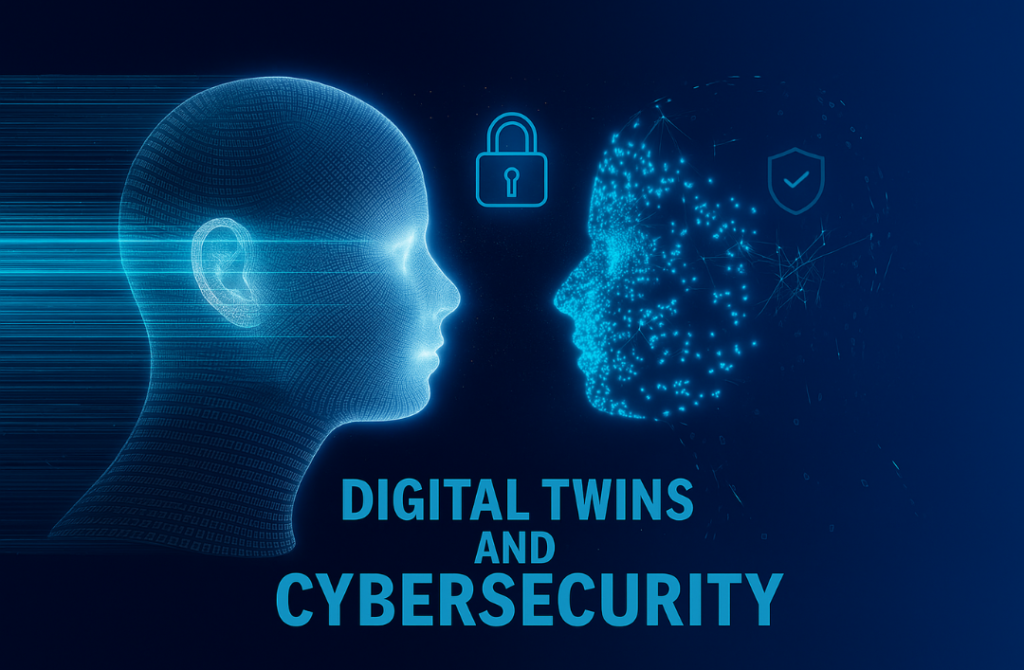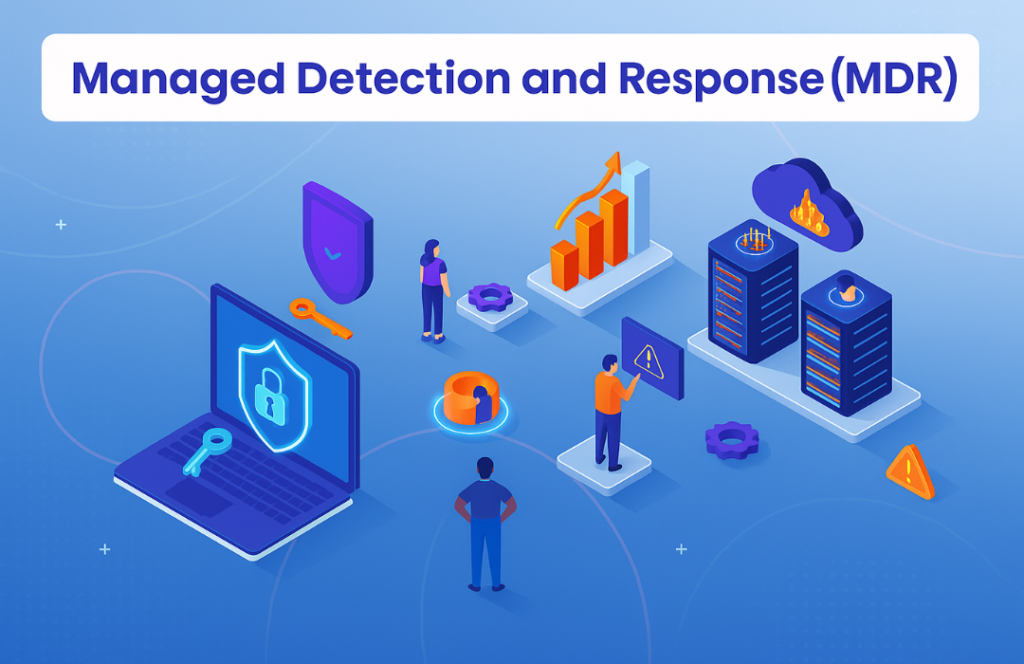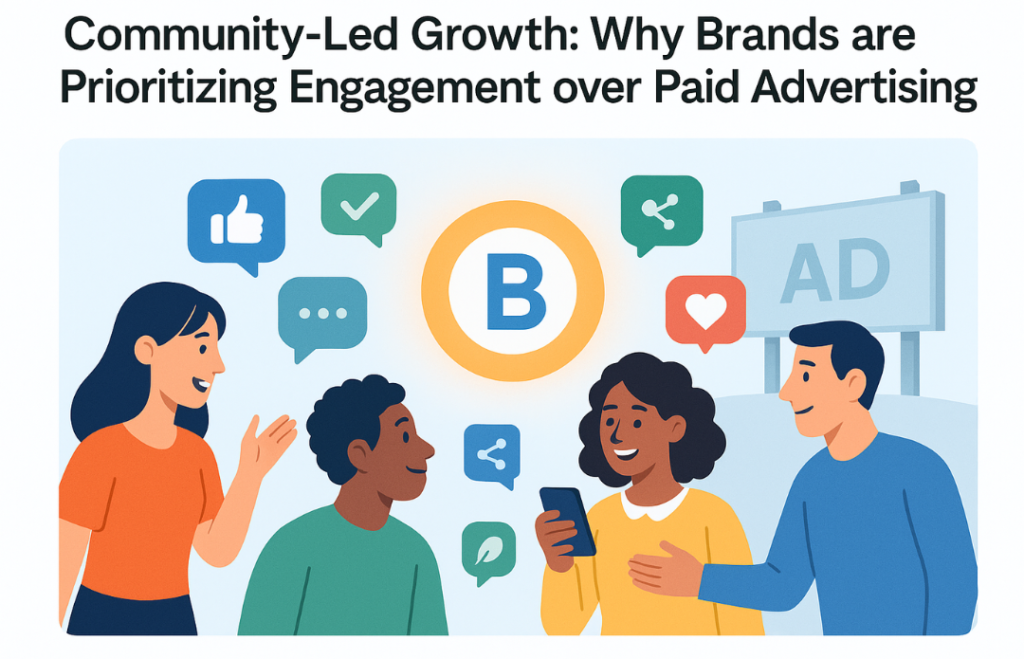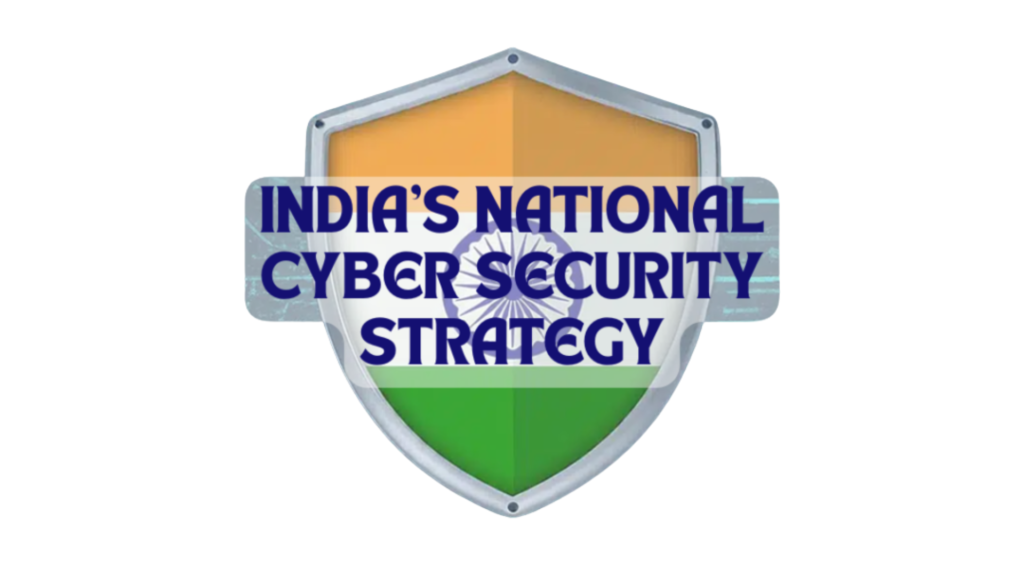Dark Social: How Hidden Sharing is Impacting Digital Attribution

Affecting Digital Attribution In a world where every impression and click is closely monitored, Dark Social is the invisible layer that marketers often overlook. It’s quietly remapping customer paths — and destroying legacy attribution models. This blog explains: What Dark Social is Why marketers must care How it harms digital attribution How to detect and respond to Dark Social Trends of the future . What is Dark Social? Dark Social was a term popularised by The Atlantic’s Alexis Madrigal in 2012 to describe web traffic created by private, untrackable sharing behaviours, including: Copy-pasting URLs into messaging apps (WhatsApp, iMessage, Telegram) Sharing links within closed social media groups Email forwards SMS messages Because these acts don’t attach referral tags such as “Facebook” or “Twitter,” analytics tools bracket them under “Direct Traffic” — concealing their actual provenance. Why Dark Social is a Big Deal for Marketers Marketers invest millions in attribution models to drive campaign optimisation and ROI measurement. But Dark Social complicates matters by: Misrepresenting high-performing channels Hiding the real content’s virality Creating blind spots in the customer journey Failing to address it leads to poor marketing decisions. How to Detect and Measure Dark Social Activity Although genuine Dark Social traffic can be hard to follow, intelligent marketers can combat its impact: 1. Review Deep Link Traffic If someone lands on an unlisted blog entry or product page — not the home page — it probably resulted from a personal share. Hack: Filter traffic in Google Analytics by Landing Page within Direct Traffic. 2. Create “Copy Link” Share Buttons Remind people to share using an actionable format that can be traced. 3. Utilise UTM Parameters Actively Pre-tag share links in emails, messaging apps and even QR codes to capture attribution. Free Tool: Google Campaign URL Builder 4. Invest in Specialised Analytics Platforms Tools such as: GetSocial.io How to Adapt Your Marketing to Dark Social Prioritise Shareable Content: Short, emotional, valuable content gets privately shared more. Encourage Private Sharing: Add “Private Send via WhatsApp” or “Email This” buttons next to social share buttons. Adopt Dark Funnel Thinking: Accept that not all touchpoints will be visible. Prioritise more nurturing and less last-click attribution. Learn more: Gartner’s “Dark Funnel” concept explained Trends Shaping Dark Social: Privacy-first browsing (e.g., Apple Mail Privacy Protection, GDPR) Encrypted messaging dominance (Telegram, Signal) Emergence of micro-communities (Discord servers, private Facebook groups) As those platforms expand, Dark Social will not only be a thing — it will rule. By 2026, more than 60% of all online conversations about brands will happen in closed ecosystems, GWI research reports. Dark Social isn’t “dangerous” — it’s an extension of human behaviour in the digital age.
Adaptive Cybersecurity: Utilizing Dynamically Retrainable Firewalls

What if your firewall could learn, adapt, and fight back—automatically? It’s 2:43 AM. Your network is humming along, quiet and secure. Suddenly, a new, unknown malware variant makes its way through the dark web backdoor. Before a standard firewall even realizes it’s there, it’s already compromised. Not this time. This time, your firewall adapts in real time. It identifies the anomaly, inspects the threat, re-trains itself and blocks it—all within a fraction of a second. Welcome to the era of dynamically retrainable firewalls, where next-generation network security meets machine learning. Why Legacy Firewalls Are Failing Quickly Legacy firewalls are rule-based—hundreds or thousands of rules. These are static, manually updated, and reactive rules. In today’s fast-paced threat landscape, this is a fatal weakness: Attackers evolve. Firewalls don’t. Emerging threats like zero-day attacks, polymorphic viruses, and AI-driven phishing payloads don’t wait around for patching cycles. They evolve on the fly. And if your defenses can’t keep pace, your data is vulnerable. Introducing Adaptive Firewalls Adaptive firewalls, powered by machine learning (ML), do not simply rely on pre-set rules. They: Ongoingly examine traffic patterns Recognize subtle anomalies in real-time Learn from emerging threats across environments Retrain themselves on new threat intelligence autonomously Think of them this way: Traditional firewalls are bouncers. Adaptive firewalls are intel analysts, forensic specialists and first responders rolled into one. So, What Makes Them “Dynamically Retrainable”? Excellent question. Here’s the key concept 1. Continuous Learning Instead of quarterly rule updates, retrainable firewalls are woven into ML pipelines that learn continuously from new data, like threat intel reports, endpoint logs, or traffic behavior in real time. Example: Palo Alto Networks’ Cortex XDR uses behavioral analytics and anomaly detection to adapt its defenses in real time, identifying threats signature-based tools miss. 2. Anomaly-Based Detection Forget rigid rules. These firewalls use unsupervised learning algorithms to detect patterns of “normal” behavior. When a deviation is seen—e.g., an unusual spurt of encrypted traffic on a rarely used port—it’s flagged, quarantined, and analyzed in real-time. 3. Real-Time Retraining With the aid of software like TensorFlow Extended (TFX) or MLflow, security devices can now dynamically—automatically—retrain their models. That is, the firewall responds nearly in real-time, battling unknown threats. Adaptive in Action: A Scenario Suppose that an attacker uses a novel C2 (command and control) protocol to extract data through an encrypted pipe. A traditional firewall? Missed it entirely. An adaptive firewall? Notices traffic pattern is not consistent with known activity for that system Suspends the connection Queries a central threat intelligence hub Flags the IP, updates its own threat model, and shares the information throughout the network All in seconds. The attack is stopped—not because the firewall observed the signature, but because it observed the behavior. Real-World Applications and Case Studies Cloudflare Cloudflare’s Magic Firewall integrates adaptive security features to safeguard cloud infrastructure from DDoS and botnet attacks. It uses real-time telemetry and behavior-based filtering to protect edge and core environments concurrently. Darktrace Powered by AI and unsupervised learning, Darktrace’s Immune System replicates the defense system of the human body. Darktrace detects and neutralizes internal threats by continuously adjusting its definition of “self” for each network it protects. Challenges to Consider Adaptive firewalls look daunting—and they do—but they are not plug-and-play. Some things to keep in mind: Quality of data matters: Trash in, trash out. Clean, correct traffic logs are required for ML models to learn. Latency trade-offs: Inspection in real time and retraining add processing latency if designed with too much sloppiness. Explainability: Black box adaptive systems. Security teams need tools to know why a decision was made (this is where Explainable AI fits in). Security of the AI itself: ML models can be poisoned. Defense mechanisms need to have validation layers and input filtering to prevent manipulation. Implementation Tips: Start Smart Not ready to redesign your infrastructure? Here’s a roadmap to begin implementing adaptive firewalls incrementally: Deploy a threat behavior analytics tool alongside your firewall Integrate SIEM (like Splunk)) with ML-based alert prioritization Feed historical log data into supervised ML models for retroactive training Use containerized ML inference engines to test real-time model updates The Future: Predictive Defense Systems In the next five years, the conversation will move from reaction to prediction. We’ll see AI agents that collaborate across networks to flag global threats. Federated learning models that preserve privacy while sharing intelligence. Fully autonomous security pipelines, from detection to mitigation And at the center of it all? Firewalls that learn. Firewalls that adapt. Firewalls that fight back. Final Word Cyber threats aren’t waiting. They’re mutating, evading, changing—always. It’s time your firewall did the same thing. Whether you’re running at the enterprise level or building next-generation cloud platforms, dynamically retrainable firewalls offer an active defense in a world of uncertainty. If you want to keep learning about Firewalls and how to safeguard yourself, join UpskillNexus.
Digital Twins and Cybersecurity: Protecting Virtual Representations of Real Systems

In today’s hyper-connected world, Digital Twins have revolutionized the process of monitoring, simulating, and optimizing real assets across industries. With new innovation, however, comes danger. As Digital Twins increasingly become a core part of mission-critical systems, cybersecurity will need to evolve to protect these virtual duplicates from potential attacks. In this blog, we shall delve deeper: What are Digital Twins? Why Digital Twin cybersecurity matters. Actual examples of cyber threats. Best practices for securing Digital Twins. Future vision and infrastructure. What is a Digital Twin? A Digital Twin is a virtual, real-time replica of an object, system or process. It is continuously supplied with data from its physical equivalent and can model what-ifs, predict outcomes, and enhance performance. Uses: Manufacturing: Predictive maintenance of equipment. Healthcare: Simulated individualized treatment. Smart Cities: Energy and traffic optimization. Aerospace: Modeling flight paths for aircraft. Why is Cybersecurity Important for Digital Twins? Digital Twins not only mirror physical assets but also control and optimize them. In the event that they are compromised, they can: Leak sensitive operation information. Interfere with critical processes. Cause physical damage through incorrect commands. Enable espionage or sabotage in industries like defense and energy Example: In 2020, security weaknesses in industrial control systems have been reported to be linked to insufficiently secured digital twin deployments. Real-World Cyber Threats and Scenarios The following are real-world attack vectors targeting Digital Twins: 1. Data Poisoning Attackers inject tainted data into the twin, leading to incorrect simulations and decisions. 2. Man-in-the-Middle Attacks Hackers intercept and tamper with the flow of information between the physical system and its twin. 3.Unauthorised Access Weak authentication frameworks allow attackers to control or exploit Digital Twin setups. 4. Intellectual Property Stealing Digital Twins are often filled with trade secrets and model intellectual property — goldmines for cyber intruders. Case Study: In 2021, cybersecurity firm Claroty discovered security vulnerabilities in digital platforms managing manufacturing twins, which exposed critical infrastructures to potential attacks. Best Practices to Protect Digital Twins Organisations must integrate cybersecurity into the DNA of their Digital Twin projects. Here’s how: 1. Secure Data Transmission Use end-to-end encryption (like TLS 1.3) between physical and digital systems. 2. Zero Trust Architecture Have strict access controls; do not trust any user or device. Do not trust any user or device. 3. Regular Penetration Testing Simulate attacks on Digital Twins to identify and fix vulnerabilities ahead of time. 4. Digital Twin-specific Risk Assessments Develop cybersecurity risk models that are specifically tailored for twin environments. 5. AI-Driven Threat Detection Use AI and ML algorithms to detect anomalous behaviours in twin data patterns. Future of Digital Twins and Cybersecurity As IoT, AI, and 5G continue to accelerate, Digital Twins will become even more sophisticated and interconnected. Future cybersecurity efforts must tackle: Autonomous threat detection. Blockchain-based data integrity. Post-quantum cryptography to future-proof against quantum computing threats. Future Trend: “Self-healing” Digital Twins, which automatically detect and repair security breaches, are actively in development. Take a look at Gartner’s view of Digital Twin development. What do we think? In a reality where the digital mirrors the physical, securing Digital Twins is no longer an option — it’s mission-critical. Companies must design, maintain, and refine their digital twin cybersecurity controls consistently to stay robust against a dynamic threat landscape. Keep in mind: The power of a Digital Twin is not its simulation but the power of its protection.
MDR (Managed Detection & Response): Why SMEs Are Breaking Away from Traditional Firewalls

With the ever-evolving world of cybersecurity, small and medium-sized enterprises (SMEs) are increasingly standing at a crossroads. Antivirus software and firewalls are no longer sufficient to protect against the constantly evolving and relentless cyberattacks of the present day. To fortify their defenses, a significant number of SMEs now turn to Managed Detection and Response (MDR) solutions. MDR offers an engaged and comprehensive cybersecurity plan that extends past the fixed shield of firewalls. While traditional security procedures have their guard down, MDR is continuously monitoring an organization’s environment, discovering new threats, and providing real-time responses to mitigate threats in real-time. This shift to MDR is redefining how organizations approach cybersecurity, and here’s why SMEs are leading this revolution. The Limitations of Traditional Firewalls Firewalls have long been the foundation of network security. Firewalls are a barrier, preventing incoming and outgoing traffic, based on particular security policies. While they are still essential, traditional firewalls are not enough when it comes to handling today’s cyberattacks. Here’s why firewalls alone may not be enough: Limited Threat Detection: Firewalls protect against known threats using signature-based detection methods only. They may not detect more complex or unknown threats, such as zero-day attacks or advanced persistent threats (APTs). Reactive, Not Proactive: Traditional firewalls are designed to block suspicious traffic but lack proactive, real-time threat detection and response capabilities. When an attack is initiated, firewalls will not necessarily be able to detect or block it. Insufficient Monitoring: Firewalls tend to be focused on dealing with access points but fail to monitor an enterprise’s network in a continuous mode for suspicious behaviour, leaving openings in security. To articulate the shortcomings of conventional firewalls in detail, this IBM whitepaper on data leakage discusses the failure of ordinary security controls to function. The Rise of MDR: Next-Gen Threat Detection and Response MDR is quickly becoming popular among SMEs as a reliable alternative to traditional firewall-based security tools. So, what exactly is MDR doing that firewalls are not? 1. Real-time Monitoring On All Systems MDR solutions provide 24/7 visibility into your cloud infrastructure, endpoints, and network. They’re designed to identify anomalies, suspicious behavior, and indicators of compromise (IoCs) in real-time. Unlike firewalls, which react to known threats only, MDR actively looks for new attacks, —be it a previously known vulnerability or an entirely new attack vector. For more information on monitoring as an ongoing process, see this CISA guide to cybersecurity best practices. 2. Active Threat Hunting MDR offerings don’t sit idly by waiting for alerts to come in—instead, they actively search out potential threats before they become full-scale attacks. Cybersecurity professionals constantly scan your environment with advanced analytics and threat intelligence to detect emerging weaknesses and prospective attack paths. This preventive action plays a crucial role in identifying threats early on, in a manner that can keep attacks from happening and growing. For more about threat hunting and how it is used toward cybersecurity, this article by SANS Institute provides a better deeper perspective on how crucial it is. 3. Rapid Incident Response When a threat is detected, MDR services are designed to respond instantly. Rather than simply alerting the IT staff, MDR providers dispatch security experts who take instant action to contain and neutralize the threat. Such instant response can prevent catastrophic damage, minimizing downtime and impact on business operations. For SMEs, such rapid response is invaluable. What it entails is that should a threat happen to breach the perimeter, there will be an opportunity to quickly respond to it, reducing the possibility of losing data or financial loss. A fine example of applied incident response practice is evidenced by the process Microsoft describes in their incident response. 4. Access to Expertise and Advanced Technology One of the key advantages of MDR for SMEs is access to advanced tools and specialized cybersecurity experts. Small businesses cannot afford to hire an in-house security operations center (SOC) or full-time experts. MDR bridges this gap by offering round-the-clock expertise without paying for an in-house team. With sophisticated machine learning and AI-based threat detection, MDR offerings can identify intricate attack patterns that would be challenging for conventional techniques to detect. For those looking to learn more about the tools behind these solutions, Microsoft’s AI and security insights are a good place to start. 5. Global Threat Intelligence MDR providers can draw upon a broad ecosystem of global threat intelligence. This allows them to stay ahead of emerging threats using real-time intelligence and information from various sources. Since MDR services have constant monitoring of new attack trends, they are able to provide early warnings of potential vulnerabilities so that companies can update systems before they are exploited. For an overview of the benefits of global threat intelligence, this World Economic Forum article describes how industry-to-industry information sharing is enhancing threat detection and response. Why SMEs Are Turning to MDR Solutions While large enterprises have the budget and expertise to build robust in-house security teams, SMEs don’t have the budget or experience to manage cybersecurity on their own. Here’s why the majority of SMEs are adopting MDR solutions: 1. Cost-Effectiveness MDR offers SMEs an affordable way of accessing enterprise-level security. Rather than invest in expensive hardware or hire a permanent security team, organizations can subscribe to an MDR solution that provides protection 24/7 at a fraction of the cost. 2. Comprehensive Coverage MDR provides comprehensive protection in all areas of an organization’s IT infrastructure—whether on-premises, cloud, or hybrid environments. Robust protection is critical with SMEs increasingly relying on cloud-based products and remote working environments. 3. Scalable Security As SMEs grow, their security needs follow. MDR solutions are both scalable and versatile, i.e., they may be adjusted in order to match changing business conditions without requiring one to totally revamp existing architectures. To read more about adaptive IT solutions, see this Gartner guide, which contains invaluable information on designing flexible cybersecurity plans. 4. Faster Response Times Through 24/7 coverage and rapid response, MDR reduces the time required to detect, isolate, and remove threats. This rapid response
Shadow AI: The Hidden Threat Waiting Within Your Organization

AI is accelerating—faster than most organizations can handle. Yesterday, you wereyou’re experimenting with a few vetted tools. Tomorrow, your teams are provisioning bespoke models, ChatGPT-unifying processes, and creating prototypes in cloud sandboxes you didn’t even know were available. Welcome to the world of Shadow AI—where AI tools and models are being used across your company, often without approval, oversight or visibility. If it sounds a bit like shadow IT, that’s because it is. But the stakes here are higher. We’re not just talking about unapproved apps. We’re talking about AI models that can leak sensitive data, make decisions or quietly expose your business to major compliance risks. So, how do we get a grip on it without killing the innovation that powers it? Let’s break it down. What Exactly Is Shadow AI? Shadow AI occurs when staff utilize AI solutions outside of what IT or security has sanctioned. It may resemble: An individual employing ChatGPT to write internal documentation without realizing they’re entering proprietary information A programmer using GitHub Copilot without verifying code exposures A product team trainstraining a custom model on customer data in a third-party cloud environment Marketing spinning up Midjourney images without verifying usage rights For the most part, it’s not malicious. People are trying to get stuff done, go fast, and see what’s possible with AI. But even good-faith use can create huge problems when it flies under the radar. Why It’s a Real Problem The thing is, AI is different from your typical software It learns. It changes. It makes decisions. And when it’s operating in the shadows, you’ve got no way of knowing what it’s doing—or what risks it’s introducing. 1. Data Exposure It’s surprisingly easy to leak data when you don’t know where your tools are sending it. Public AI tools run prompts on their servers. If someone pastes in sensitive client info or unreleased code, that data may live on in ways you can’t control. IBM describes data leakage risks well. 2. Security Blind Spots Most shadow AI tools have not been security-reviewed. They may not even encrypt data. Others have weak APIs with minimal or no authentication. If these models interact with production systems or sensitive data, they can introduce vulnerabilities for attackers. CISA does a great job of explaining these risks. 3. Lack of Accountability What if an unauthorized AI tool provides poor advice, marks the wrong customer, or suggests a biased candidate? Without logging, auditing, or documentation, it’s difficult to even know what occurred, —much less correct it. 4. Compliance and Regulation With the EU AI Act and other such laws, plus increased scrutiny by regulators, implementing untested AI tools can put your company into trouble—in a hurry. Here’s some nice background reading on AI policy in the EU. Why Shadow AI Is Prevalent Don’t pin it on the team yet. Shadow AI frequently has noble beginnings: users wanting to make their work more efficient. Yet it occurs due to: Teams are frustrated by slow procurement processes There is no policy for what is permitted Individuals do not understand that AI tools can pose serious threats Innovation is fostered, —but without oversight If AI regulation is too strict, individuals circumvent it. If there is no regulation at all, they go crazy. The solution? Strike a middle ground. How to Respond Without Shutting Things Down The objective isn’t to shut everything down and stifle creativity. The objective is to establish secure parameters for intelligent discovery. Here’s how you can begin. 1. Recognize What’s Occurring Denial won’t work. Pretend shadow AI isn’t happening. Think it’s already occurring—and approach from a position of curiosity, not retribution. 2. Teach, Don’t Simply Restrict Hold in-house workshops that discuss what’s acceptable and what’s not. The average employee is not a security specialist. They merely require clarity. A decent guide: NCSC’s fast tips for being safe online. 3. Establish a Safe Place to Play Create an internal sandbox where groups can experiment with AI tools using mock data or sanctioned use cases. If you provide individuals a “legal” area to play, they are less likely to stray. 4. Establish Your Governance Model You don’t have to boil the ocean. Begin small. Which tools are sanctioned? What data can and cannot be utilized? Who should be brought in when someone trains a new model? Microsoft provides a useful governance model for public sector AI, —but it works just as well for enterprise. 5. Appoint AI Stewards Consider these your internal advocates—individuals who get both AI and the business. They can serve as advisors and gatekeepers, helping to vet tools before they’re deployed widely. The World Economic Forum suggests this type of role. 6. Monitor—Lightly and Transparently You don’t have to micromanage, but do monitor usage patterns. Monitoring tools such as proxy monitoring or API gateways can be used to identify spikes in usage to unauthorized services. SANS has some ideas on monitoring here. Final Thoughts Shadow AI is a sign that people want to do more with the tools they have—and that’s not a bad thing. It’s an opportunity to meet your team where they are, build smarter guardrails, and make unseen risk a tangible innovation. The companies that succeed with AI won’t be the ones who act most rigidly. They’ll be the ones who establish trust, train their staff, and install just enough structure to allow AI to flourish —securely. Let’s illuminate what’s lurking in the dark. ToBecause to avoid it? That’s the true danger.
B2B Marketing Strategies: How to Generate More Leads in 2025

The B2B marketing environment is changing at a fast pace, with technology developments and changing consumer behavior transforming how companies create leads. In 2025, marketers need to adopt new approaches to remain competitive and attract high-quality leads. At UpskillNexus, we equip digital marketers with new insights to thrive in these transitions. Below are the best B2B marketing strategies to produce more leads in 2025. 1. Personalized Account-Based Marketing (ABM) Account-Based Marketing (ABM) remains a top B2B marketing strategy. This year, 2025, personalization will elevate ABM to its new heights. Companies will use AI-driven data analysis to send highly personalized content and focused advertising to precise accounts. ABM campaigns will incorporate: AI-based insights to determine perfect-fit prospects and forecast buying behaviors. Hyper-personalized content aligned with the objectives of target companies’ decision-makers Multi-channel engagement, integrating email, LinkedIn outreach, and tailored landing pages. 2. AI-Powered Lead Scoring and Automation Artificial Intelligence (AI) is transforming B2B marketing by making lead scoring and automation more accurate. AI applications scan huge amounts of data to score prospects on their chances of converting, allowing sales teams to concentrate on high-potential leads. Why does it work? Automated email workflows that nurture leads with tailored messaging. Predictive analytics to improve lead qualification criteria. Chatbots and virtual assistants to interact with prospects in real time, responding to questions and pointing them to relevant content. 3. Interactive and Immersive Content Marketing Static content is becoming less effective. In 2025, interactive and immersive experiences will generate greater engagement and lead conversions. Businesses will employ: Webinars and virtual events to inform prospects and create leads. AI-driven quizzes and assessments to deliver tailored solutions. Augmented Reality (AR) and Virtual Reality (VR) demos to present products in real-world use cases. 4. Social Selling and LinkedIn Outreach LinkedIn continues to be a force to be reckoned with when it comes to B2B lead generation. Social selling in 2025 will be more sophisticated, with companies using LinkedIn’s sophisticated targeting capabilities and AI-powered recommendations. Establishing thought leadership by posting high-value content and insights. Having substantial conversations with prospective leads through comments and direct messages. Utilizing LinkedIn Sales Navigator to find and connect with decision-makers. 5. SEO and Voice Search Optimization SEO is still a vital lead generation tool, but in 2025, voice search and AI-based search algorithm optimization will be the key. Companies need to concentrate on: Conversational keywords to match voice search queries. Optimized long-form content that offers detailed solutions to industry problems. Schema markup to enhance search engine visibility and featured snippet rankings. 6. Sustainable and Ethical Marketing With sustainability rising as a top concern for companies, weaving ethical and environmentally friendly messaging into B2B marketing will build brand credibility and appeal to conscious consumers. Sustainable marketing practices are: Emphasizing corporate social responsibility (CSR) efforts in content and campaigns. Employing sustainable packaging and digital options for marketing collateral. Implementing carbon-neutral hosting and green technology in online marketing initiatives. 7. Influencer and Partner Marketing Strategy B2B influencer marketing is on the rise, and industry thought leaders and experts will be driving brand credibility. Companies will partner with niche influencers to reach more audiences and create leads. Successful methods include: Working with industry influencers for webinars, guest blogs, and social media partnerships. Co-hosting podcasts and events with industry-established figures. Using customer testimonials and case studies as social proof. 8. Data Privacy and Compliance-Driven Marketing With changing data laws like GDPR and CCPA, companies have to implement ethical data gathering and usage methods. Transparency and conformity will become central to lead generation and retention. Some of the main strategies are: Getting consent for data harvesting and marketing emails. Giving value-based content for user data. Having cybersecurity policies to safeguard customer data. Why B2B Lead Generation Matters in 2025 The answer is quite simple: B2B marketing is more dynamic than ever before. Companies need to adopt innovative approaches to capture and cultivate high-quality leads. Digital transformation, AI-powered insights, and responsible marketing will be the keys to success in 2025. At UpskillNexus, we provide in-depth training on B2B marketing techniques, empowering professionals to thrive in the changing times. From learning AI for lead generation to maximizing social selling methods, we assist marketers in leading the pack. Ready to raise your B2B marketing game? Join us at UpskillNexus today and lead the way in 2025!
Community-Led Growth: Why Brands Are Prioritizing Engagement Over Paid Ads

The Move Away from Paid Advertising toward Community Engagement The online marketing scenario is changing fast, and Indian businesses in 2025 are moving away from traditional paid promotion to community-based growth strategies. With growing skepticism around ads and stiff competition for online presence, generating organic interest is now a necessity for sustainable success. UpskillNexus enables digital marketers with cutting-edge strategies, and community-based marketing is leading the way in this revolution. Businesses have depended on pay-per-click (PPC) ads to funnel traffic and business for years. Yet today’s consumers are even more discerning about what content they consume. Ad fatigue, banner blindness, and increasing costs of acquiring a customer have seen brands look at alternative marketing models. Community-driven growth (CLG) involves cultivating loyal user bases, trusting them, and crafting real engagements over simply shove-advertising. The Power of Brand Communities A powerful brand community is a place where customers engage, exchange stories, and evangelize the brand. Such communities can be established using social media platforms, closed forums, or branded apps. For example, bhag.club, a rapidly growing fitness community in India, invites running enthusiasts to join challenges, discuss, and share their journey. This feeling of belongingness creates intense engagement and loyalty, leading to organic growth. User-Generated Content (UGC) as a Growth Driver User-generated content is now one of the most effective weapons in people-focused marketing. Rather than made-for-ad creatives, brands now get regular customers to tell their stories through photos, videos, and testimonials. The content establishes credibility and authenticity, encouraging possible buyers to convert. For instance, Frido, an ergonomics lifestyle brand with ergonomic products, has effectively harnessed the power of UGC by motivating consumers to upload genuine usage scenarios, increasing credibility and organic impressions. Influencer & Brand Advocates Leverage Rather than splurging on celebrity endorsement, companies now engage with nano and micro influencers with activated groups. Such influencers share a greater affinity with the community, delivering higher conversion rates compared to usual paid campaigns. As an example, Minimalist, which is an Indian indigenous skincare brand that is soon to be acquired by HUL at ₹3,000 crores, works with skincare professionals and aficionados who produce tutorial videos and product reviews. This local approach increases authenticity and word-of-mouth promotion. Membership Programs & Exclusive Communities Indian businesses are introducing membership programs and invite-only communities to enhance customer relationships. These sites offer early access to products, insider content, and personalized support, creating a perception of exclusivity. One of the best examples is Zomato Gold, which provides premium dining and delivery benefits, giving rise to a loyal customer base that goes beyond food delivery services. Interactive Experiences for Community Engagement Interactive content such as polls, quizzes, live Q&A sessions, and webinars are also instrumental in creating engagement. Brands are increasingly leveraging tools such as WhatsApp Communities, Telegram groups, and Facebook Groups for live conversations, co-creation, and advocacy. Blinkit, for instance, India’s largest quick-commerce platform, engages actively with its community on social media polls and interactive campaigns, so that users feel they are a part of brand decision-making. Data-Driven Personalization Community marketing is not about engagement; it’s about learning about consumer affinity. Brands are using first-party data gathered from community interactions to personalize content, product recommendations, and user experience. This data-driven strategy strengthens customer retention and loyalty. The Future of Community-Led Growth As marketing trends become more digital, brands that focus on community engagement over usual advertising will be at a competitive advantage. Word-of-mouth referrals, authentic interactions, and real connections are turning out to be stronger drivers of sustainable growth than paid advertising. Why Community-Led Growth Matters to You in 2025 With increasing ad budgets and changing customer behavior, mastering community marketing is an essential competence in the marketplace today. We at UpskillNexus teach comprehensive courses in community development methodologies, empowering marketers with the tools to leverage interaction for business acceleration. From constructing online communities to utilizing user-generated content, we train you for success in the new digital landscape. Ready to shift from paid advertising to organic engagement? Join UpskillNexus today and lead the way in community-driven growth!
How regional language content is shaping digital marketing strategies

Introduction Did you know that more than 75% of internet users prefer to consume content in their native language? As digital marketing continues to grow, brands are discovering the sheer potential of regional language content. It’s not merely about reaching more people; it’s about engaging with them genuinely. With the penetration of the internet growing in non-English-speaking areas, online marketing strategies are now changing to encompass vernacular content—from social media promotions to voice search and AI-based localization. Let’s dive into how brands are using regional language content to increase engagement and conversions. 1. The Age of Vernacular Content in Digital Marketing Digital marketers are transcending English-oriented content to access a more heterogeneous and active base. Here’s why: ✅ Broader Reach of the Audience – India alone boasts more than 500 million internet users who prefer languages at a local level over English. ✅ Improved Engagement & Trust – Users relate better to content in their native language, boosting engagement and conversion rates. ✅ SEO Benefit – Regional language content benefits brands by ranking them higher on Google Voice Search and local queries.Case Study: Amazon and Flipkart have launched multilingual shopping experiences, which allow non-English users to shop and navigate more easily. Where to Begin? Translate social media posts and blogs through Google Translate. Localize advertising campaigns to align with regional tastes. Optimize websites for multilingual SEO. 2. Social Media and Video Marketing in Regional Languages ✅ Social media sites are driving the boom in vernacular content. Through sites such as YouTube, Instagram, and ShareChat, regional influencers are changing the way brands speak. ✅ YouTube – More than 90% of video viewing in India is in the regional language. Brands such as Zomato and Swiggy produce hyperlocal campaigns specific to various states. ✅ Instagram & Facebook – Brands employ multi-language posts and region-based hashtags to increase engagement. ✅ ShareChat & Moj – These Indian apps exclusively serve non-English users, presenting an innovative avenue for brands to reach local users. Tip: Collaborate with local influencers to produce organic and real-world content. Explore influencer marketing platforms such as Upfluence and AspireIQ to reach the right creators. 3. AI-powered localisation and Voice Search Optimization With the emergence of voice search and AI translation tools, it is now possible for brands to scale their regional content marketing campaigns with ease. ✅ Voice Search in Regional Languages – 58% of Indian smartphone users employ voice search in their own language. ✅ AI Translation Tools – DeepL and Google’s Neural Machine Translation are two such platforms that allow real-time content translation. ✅ Chatbots & Customer Support – Multilingual support through AI-based chatbots, such as Drift and Tars, to provide an improved user experience. chatbots – How to Implement? Maximize website content for regional language SEO. Make Google Assistant and Alexa voice search compatible. Utilize AI-based chatbots for customer support across various languages. Conclusion Regional language content isn’t a trend, it’s the future of digital marketing. By adopting vernacular marketing, brands can unlock new customer segments, establish more meaningful relationships, and achieve greater conversions. The question is: Is your brand ready to talk the language of its audience? Leave us a comment below on how you are going to add regional language content to your digital strategy!
How to Write a Blog That Ranks on Google (Even in a Competitive Niche)

Introduction Did you know that 90% of online experiences start with a search engine? Ranking on Google, particularly in a competitive niche, is not luck—it’s strategy In the increasingly expanding digital world, creating a remarkable blog demands something more than a well-written piece. You need to search-engine-optimize, but still create an experience worth reading. Let’s take a look at how you can produce a Google-ranking blog even if you are battling industry titans. 1. Begin with Keyword Research Before you begin writing, you must understand what your audience is looking for. Proper keyword research assists you in finding the correct topics and search engine optimization of your content. ✅ Utilize SEO Tools – Tools such as Ahrefs, SEMrush, and Google Keyword Planner assist in discovering high-traffic, low-competition keywords. ✅ Target Long-Tail Keywords – These precise phrases attract targeted traffic and are simpler to rank for. ✅ Competitor Analysis – See what keywords top blogs in your niche are going for and find gaps in content. Case Study: A blog about personal finance drove traffic up 120% by moving away from broad keywords such as “saving money” to long-tail terms such as “best ways to save money in your 20s.” 2. Produce High-Quality, Useful Content Google’s algorithm favours content that is useful, interesting, and authoritative. Here’s how you can do it: ✅ Write Thorough Content – Address every facet of a subject, answering frequently asked questions. ✅ Use Clean Formatting – Use headings, bullet points, and brief paragraphs for easy reading. ✅ Add Visuals – Infographics, videos, and photos increase engagement and shareability. Tip: Use the E-E-A-T model (Experience, Expertise, Authoritativeness, and Trustworthiness) to establish credibility in your domain. 3. Optimize for On-Page SEO Search Engine Optimization of your blog will help it reach the intended audience. ✅ Title & Meta Description – Naturally incorporate your target keyword and make them enticing. ✅ Internal & External Links – Link to expert sources and related internal pages to improve credibility. ✅ Use Schema Markup – Apply structured data to increase search visibility (e.g., FAQs, reviews). 4. Create High-Quality Backlinks Backlinks serve as recommendations for your content, telling Google that your blog is valuable and credible. ✅ Guest Blogging – Publish articles on authoritative sites in your niche to gain backlinks. ✅ Broken Link Building – Identify broken links on authoritative sites and propose your content as a replacement. ✅ Do Digital PR – Get listed in industry roundups and expert opinion pieces. Pro Tip: Leverage HARO (Help a Reporter Out) to engage with reporters and gain backlinks from authoritative sites. 5. Optimize for User Experience & Core Web Vitals Google favours websites that provide an excellent user experience. Make sure your blog is: ✅ Mobile-Friendly – Over 60% of searches are on mobile devices. ✅ Fast-Loading – A slow site can penalize rankings; optimize images, enable caching. ✅ Secure (HTTPS) – Google prefers secure sites with SSL certificates. 6. Use Social Media & Content Sharing Even great content requires a boost to catch on. Here’s how you can make it go further: ✅ Share on Social Media – Sites like LinkedIn, Twitter, and Facebook can drive traffic. ✅ Participate in Online Communities – Post in forums such as Reddit and Quora. ✅ Repurpose Content – Repurpose your blog into videos, infographics, or podcasts for broader coverage. Conclusion Google ranking a blog, particularly in a niche with a lot of competition, involves a combination of SEO, quality content, and promotional effort. With attention to keyword research, search engine optimization, and authority building, you can stand a better chance of ranking higher and generating traffic consistently, even if the blog you are reading was written after carefully following these steps. The question is: Are you prepared to put these into practice and scale the ranks? Leave a comment below on your favorite blog-ranking tactic!
India’s National Cyber Security Strategy: What it aims to achieve and challenges in implementation

India’s National Cyber Security Strategy: Objectives and Challenges Introduction As India digitizes at a fast pace, cybersecurity has emerged as a national imperative. Nearly every sector, ranging from financial transactions to critical infrastructure, depends on digital networks. Yet, with increasing cyber threats like ransomware attacks and data breaches, a top-level cybersecurity strategy is more necessary than ever. That is where India’s National Cyber Security Strategy (NCSS) enters the picture. This blog discusses the main goals of NCSS and the difficulties in its implementation. Goals of India’s National Cyber Security Strategy Critical Infrastructure Protection Improvement: India’s critical infrastructure, which includes banking, electricity generation and distribution networks, and healthcare, is extremely susceptible to cyber attacks. NCSS seeks to enhance resilience by mandating regular security audits for government and private sectors, next-generation threat detection systems to detect and isolate threats, and better coordination between cybersecurity institutions to facilitate speedier responses. Establishing a Secure Cyber Environment: To protect online transactions and personal information, NCSS stresses the importance of a security-by-design ethos in software and hardware development. It also promotes local cybersecurity solutions to minimize reliance on external technology and works towards making data protection legislation stronger to protect users’ private information. Cyber Security Training and Capacity Building: A good cybersecurity system depends on well-trained personnel. NCSS emphasizes national awareness campaigns for educating the general public and business communities regarding cyber threats. It also seeks to incorporate cyber studies into high school and university studies and facilitate re-skilling programs through state-supported certification training. Cybercrime Investigation and Law Enforcement Enhancement: As cybercrimes evolve in complexity, law enforcement agencies have to keep pace. NCSS suggests the creation of a National Cyber Crime Coordination Center (NCCC) specifically for tracking and responding to threats. It also calls for enhanced coordination among national and state law enforcement agencies to speed up investigations and suggests speedy processing of cybercrime cases through specialized courts Challenges in Implementation Shortage of Cybersecurity Professionals: While demand is increasing, India lacks trained cybersecurity professionals. Meeting this need involves long-term investment in education and training programs to create skilled manpower. Financial Constraints: While security is a priority, the availability of funds tends to slow down necessary infrastructure and research development. Public-private partnerships can plug this fiscal deficit. Regulatory and Compliance Issues: Most sectors grapple with unclear cybersecurity regulations, resulting in inconsistent enforcement. Tighter regulations and more stringent enforcement measures are necessary to promote greater compliance. Emerging Threat Environment: Cyber threats evolve continuously, and it becomes challenging for policies to remain relevant. A dynamic, frequently updated strategy is essential to effectively address new and emerging threats. The Road Ahead India’s National Cyber Security Strategy can change the face of digital security in the country. For this to be achieved, there has to be smooth cooperation among the government, private industry, and people. Cyber attacks are not simply IT issues—these are issues of national security. Individuals and companies can make a difference by being well-informed and aware, thus making digital India a safer place What is your future vision for cybersecurity in India? Share your thoughts in the comments below!
